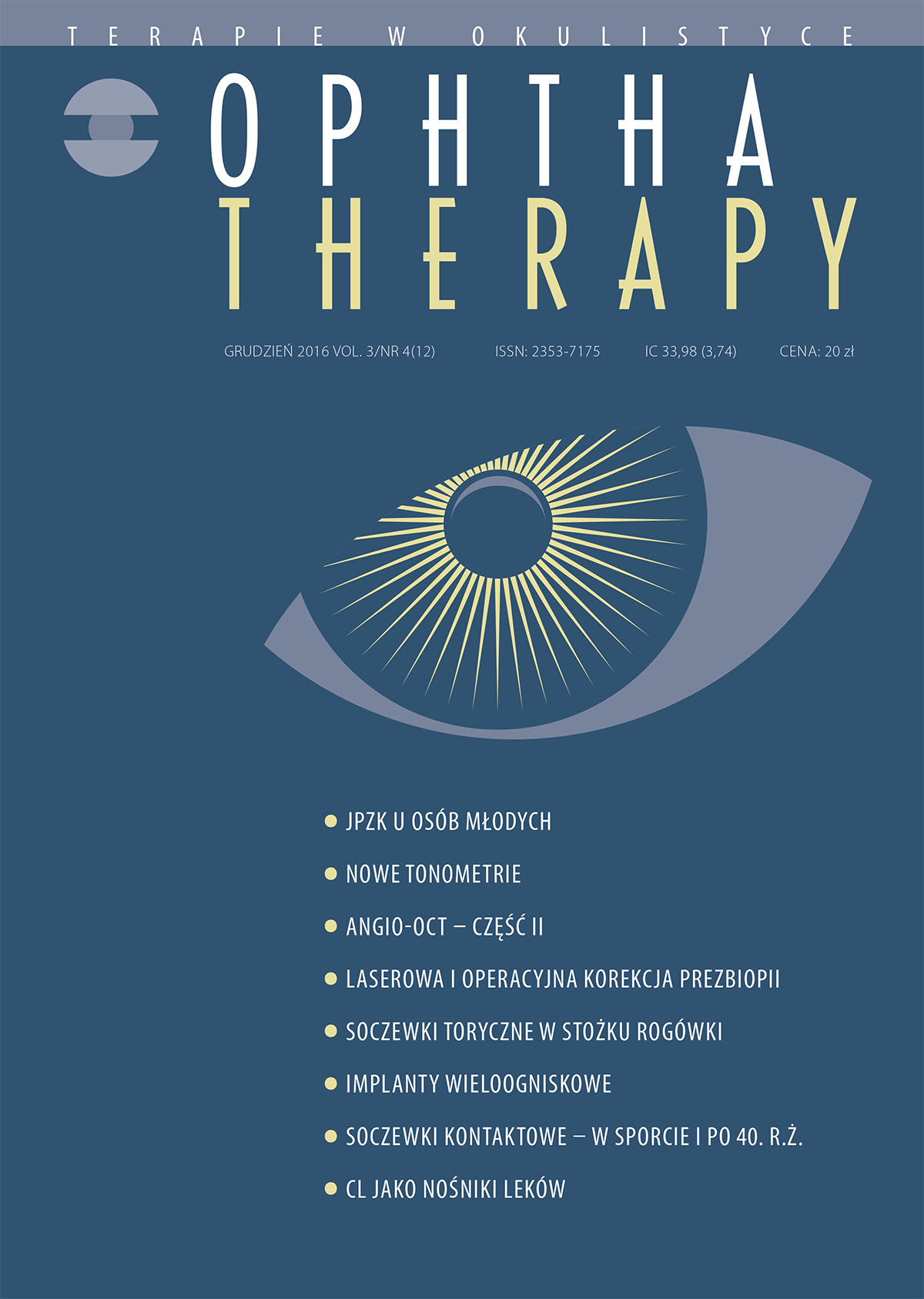Wykorzystanie soczewek kontaktowych jako nośników leków okulistycznych
##plugins.themes.bootstrap3.article.main##
Abstrakt
Użycie soczewek kontaktowych jako nośników leków okulistycznych stwarza obiecującą alternatywę dla ich podawania w formie kropli. Jednak zamaczanie soczewek w roztworze leku jest mało wydajne, gdyż większość preparatu uwalnia się w ciągu kilku godzin. Dotychczas zaproponowano kilka metod mających zwiększyć możliwości soczewek kontaktowych w zakresie załadowania jak największej ilości leku i wydłużenia czasu jego uwalniania z macierzy soczewki, np. nadrukowywanie molekularne, zaopatrywanie w bariery dyfuzyjne w postaci witaminy E, wzbogacanie podstawowego polimeru funkcjonalnymi monomerami, wbudowywanie leku zamkniętego w nanokapsułkach w macierz soczewki lub tworzenie nanodomen zawierających lek wewnątrz soczewki.
Pobrania
##plugins.themes.bootstrap3.article.details##

Utwór dostępny jest na licencji Creative Commons Uznanie autorstwa – Użycie niekomercyjne – Bez utworów zależnych 4.0 Międzynarodowe.
Copyright: © Medical Education sp. z o.o. License allowing third parties to copy and redistribute the material in any medium or format and to remix, transform, and build upon the material, provided the original work is properly cited and states its license.
Address reprint requests to: Medical Education, Marcin Kuźma (marcin.kuzma@mededu.pl)
Bibliografia
2. Filipe HP, Henriques J, Reis P et al. Contact lenses as drug controlled release systems: narrative review. Revista Brasileira de Oftalmologia. 2016; 75(3): 241-7.
3. Guzman-Aranguez A, Colligris B, Pintor J. Contact Lenses: Promising Devices for Ocular Drug Delivery. J. Ocul. Pharmacol. Ther. 2013; 29: 189-99.
4. Hu X, Hao L, Wang H et al. Hydrogel Contact Lens for Extended Delivery of Ophthalmic Drugs. Int J Polym Sci. 2011; ID: 814163. https://doi.org/10.1155/2011/814163 .
5. Peng C, Burke MT, Carbia BE et al. Extended drug delivery by contact lenses for glaucoma therapy. J Control. Release. 2012; 162: 152-8.
6. Maulvi FA, Mangukiya MA, Patel PA et al. Extended release of ketotifen from silica shell nanoparticle-laden hydrogel contact lenses: in vitro and in vivo evaluation. J Mater Sci. 2016; 27: 113.
7. Kapoor Y, Thomas JC, Tan G et al. Surfactant-laden soft contact lenses for extended delivery of ophthalmic drugs. Biomaterials. 2009; 30: 867-78.
8. Changhai LU, Roshan B, Kociolek M et al. Hydrogel Containing Silica Shell Cross-Linked Micelles for Ocular Drug Delivery. J. Pharm. Sci. 2013; 105(2): 627-37.
9. Paradiso P, Serro AP, Saramago B et al. Controlled Release of Antibiotics From Vitamin E-Loaded Silicone-Hydrogel Contact Lenses. J. Pharm. Sci. 2016; 105(3): 1164-72.
10. Xu J, Li X, Sun F. In vitro and in vivo evaluation of ketotifen fumarate-loaded silicone hydrogel contact lenses for ocular drug delivery. Drug Deliv. 2011; 18(2): 150-8.
11. Peng C, Chauhan A. Extended cyclosporine delivery by silicone-hydrogel contact lenses. J Control. Release. 2011; 154: 267-74.
12. dos Santos JF, Alvarez-Lorenzo C, Silva M et al. Soft contact lenses functionalized with pendant cyclodextrins for controlled drug delivery. Biomaterials. 2016; 30(7): 1348-55.
13. Luliński P. Polimery ze śladem molekularnym w naukach farmaceutycznych. Polimery. 2010; 11-12: 797-805.
14. Tashakori-Sabzevar F, Mohajeri SA. Development of ocular drug delivery systems using molecularly imprinted soft contact lenses. Drug Dev. Ind. Pharm. 2015; 41(5): 703-13.
15. Yañez F, Martikainen L, Braga MEM et al. Supercritical fluid-assisted preparation of imprinted contact lenses for drug delivery. Acta Biomaterialia. 2011; 7: 1019-30.

